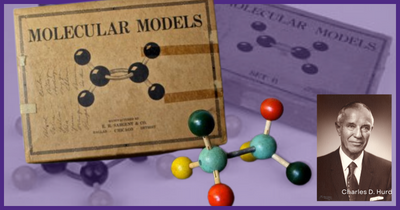Molecular Models
 Molecular Models: The first ball-and-peg chemistry kit
Molecular Models: The first ball-and-peg chemistry kit
The first ball-and-peg models to help students visualize molecules in 3D was conceptualized by Professor Charles Hurd. In the late 1920’s, Hurd was looking for better ways to teach his students organic structure and stereochemistry when he became inspired by the Evanston company, Toy Tinkers. Their product “Tinkertoys” provided a variety of balls and pegs for children to construct individual toy designs. When Toy Tinkers decided their company was not the right fit for developing chemistry sets, Hurd coordinated with friends Wallace Brode and Cecil Boord of Ohio State University. Utilizing the wooden pegs provided by Toy Tinkers and a company based in Maine for the balls, the company “Molecular Models” was created in 1930. Each kit was priced barely above cost to encourage organic teachers require students purchase a kit along with their textbook. By the time Sargent took over the business in June 1949, about 10,000 sets had been sold.
After this kit was developed, the “ball and spoke model” became a common way of representing molecular structures. Every wooden ball is given a color and a certain number of holes drilled into it. These holes correspond to the number of bonds that an atom can form with other atoms. A bond can be formed depending on how many electrons an atom has, which varies by element. Oxygen atoms, for example, can form two bonds, but hydrogen atoms can only form one. The Molecular Model allowed students to visualize the bonds between differing atoms.
Source Material:
1. Journal of Chemical Education 1989 66(12), 984
2. The Chemical Heritage Foundation oral history interview with Charles Hurd
Synopsis by K. Levander
